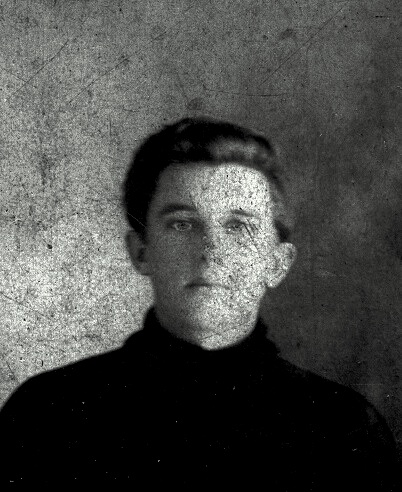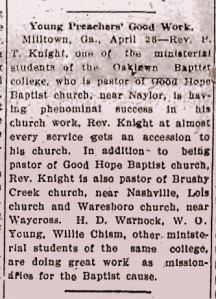- Wayne County Beginnings 1803-1827
- Settling Lowndes County 1827-1836
- Seminole Wars 1836 – 1842
- Antebellum Wiregrass 1843 -1860
- Civil War 1861-1865
- Wiregrass Reconstruction 1866-1870
In November of 1827 Levi J. Knight became the original settler at Beaverdam Creek, Lowndes County, GA (now Berrien county). At the age of 24, he was already a leader, experienced in military matters and in civil service. He was a man of action, an Indian fighter, and he was among the earliest pioneers to settle in the Wiregrass area of southern Georgia. To this newly opened land he brought his new bride, Ann D. Herrin Knight. The couple had married just a few days earlier, on Nov 14, 1827 in an area of Wayne County that is now Brantley County, Georgia.
Levi’s parents, Sarah and William Anderson Knight, brothers Aaron Knight, William C. Knight, Jonathan Knight and others of the family connection had preceded them, having settled in Lowndes County two years earlier. Levi J. Knight’s homestead became the nucleus of a community first known simply as Knight, that later grew into present day Ray City, GA.
Wayne County Beginnings
Levi was born on the first of September, 1803 in Wayne County, Georgia. His mother was Sarah Cone Knight; his father, Elder William Anderson Knight. Levi grew up in Wayne County at the southern frontier of the young American nation. Wayne county had only been officially created by the Georgia General Assembly just three months before he was born. This land had been the ancestral home of the Creek Indians, and there was continuing conflict between the Native Americans and encroaching settlers. Despite efforts of the state of Georgia to take the Creek land by treaty, conflicts continued as the Georgia Land Lotteries brought more settlers to the area.
Levi J. Knight’s family had been among the first to settle in Wayne county, his parents having arrived there in 1803 prior to his birth. The Knights were well positioned in the community, and already had a long tradition of military service. Both of Levi’s grandfathers were veterans of the Revolutionary War. His paternal grandfather, John Knight, had been a sergeant in the 1st Georgia Battalion of Continental Troops in the American Revolution and had received several land grants in South Carolina, Georgia, and in Spanish Florida. On his mother’s side, his grandfather was William Cone, a Baptist pastor and Revolutionary soldier who served as a captain in McLean’s Regiment of Georgia Troops, under General Francis Marion. William Cone served as a major in the 1st Battalion of the Richmond County Militia (see Levi J. Knight’s Military Heritage).
While Levi J. Knight was a young boy, his uncle Jonathan Knight was sheriff of Wayne County from 1810-1812 and became Captain of the Wayne County militia in 1813. No doubt Captain Knight regaled his young nephew with pioneer tales- true stories all – of cattle ranching, tracking run-away slaves, and fighting privateers in Spanish Florida. At just 15 years old, Levi J. Knight served as a private in the Wayne County militia. The militia was engaged in defending the frontier settlers from Indian attacks that continued even after the Creek War of 1814.
On May 3rd, 1824 extant legal records note that Levi J. Knight, along with Robert Stafford posted sureties in the amount of $500 for Sibbiah O’Neil [or O’Neal] for the guardianship of Martha and Mary T. O’Neil. The O’Neals were friends of the Knights. Later, Sarah Amanda “Sallie” O’Neal, daughter of Henry O’Neal and Jane Dowden, would marry Levi J. Knight’s nephew, Levi J. Knight, Jr. (son of John and Sarah Knight).
Before he was 21, on June 16, 1824 Levi was appointed as Sheriff of Wayne County to serve out an unexpired term. Shortly after that, his parents relocated to the soon-to-be-created Lowndes County area. His father, William A. Knight, was elected as the first state senator from the new county, and his brother Jonathan was elected as the first representative. Levi J. Knight served on the jury in the first Superior Court of the new county.
According to state records, in 1826 Levi J. Knight was working as a state surveyor mapping land in north Georgia newly ceded by the Creek natives. The Official Register of Land Lottery of Georgia, 1827 shows he was a “fortunate drawer” in the land lottery of 1827, having received Lot 223, District 23, Section 1 (Lee County, GA), in the drawing of April 24, 1827.
It was in this situation that Levi courted and smartly married the former Mrs. Ann Donald Herrin. She was the 25 year-old daughter of William and Elizabeth Clements, a well-to-do family of Wayne County. Levi J. Knight and Ann Herrin were wed on November 14, 1827 in Wayne County, Georgia. Jonathan Knight, Justice of the Peace completed the marriage license. Just days later, the newlywed pioneers headed south to settle on Beaverdam Creek in Lowndes County (now Berrien), Georgia.
From 1832 to 1840 Levi J. Knight was elected six times to the Georgia Assembly as the Senator from Lowndes County. His father had served in the same office before him. L. J. Knight was a contemporary of John M. Berrien, for whom Berrien county was named.
Children of Levi J. Knight and Ann D. Clements Herrin:
- William Washington Knight – born about 1829 Lowndes (now Berrien) County, GA; married Mary Elizabeth Carroll; died December 27 , 1863 Berrien County, Georgia
- Elizabeth Knight – born April 14, 1830, Lowndes County, Georgia; married Hardeman Sirmans; died September 6, 1912, Berrien County, GA
- John Graham Knight – born June 23, 1832 Lowndes (now Berrien) County, GA; married 1) Eliza B. Carter, 2) Mary Ann Davis; died May 8, 1908 Ray’s Mill, Berrien County, Georgia
- Sarah “Sally” Knight – born April 6, 1831 Lowndes (now Berrien) County, GA; married Gideon Gaskins; died April 13, 1903
- Mary Adelaide Knight – born about 1836 Lowndes (now Berrien) County, GA; married Thomas M. Ray; died November 11, 1923
- Levi A. Knight – born about 1838 Lowndes County, GA; died about 1856
- Jonathan David Knight – born April 2, 1840 Lowndes (now Berrien) County, GA; married Emily E. Brandon; died March 9, 1884
- Keziah A. Knight – born about 1843 Lowndes (now Berrien) County, GA; married her cousin, James Aaron Knight, in 1858
Sources:
- Huxford, F. (1922). Marriage Licenses Wayne County, Ga. in The South Georgia historical and genealogical quarterly A quarterly magazine devoted to the history and genealogy of southern Georgia and its settlers. Homerville, Ga: [s.n.]. Copied from Book “C” of transcribed records, pages 176 to 204, Covering Years 1809 to 1850. Available online at http://www.archive.org/details/southgeorgiahist00huxf
- Huxford, F. 1951. Pioneers of Wiregrass Georgia, Vol 1. pg 159
- Hill, L. 2005. The CONE FAMILY HISTORY and its Variants such as MacCone, Kohn, Coan: Scotland/Ireland immigrants to USA. pgs 1822-1823
- http://homepages.rootsweb.ancestry.com/~soup/Campbell/ps36/ps36_337.htm
- Huxford, F. (1916). History of Clinch County, Georgia, , comp. and ed. by Folks Huxford. Macon, Ga: J.W. Burke. pg. 265
- OLD RECORDS BOOK “H” OF BONDS, WAYNE COUNTY, GEORGIA, COURT OF ORDINARY, FIRST 77 PAGES in THE SOUTH GEORGIA HISTORICAL AND GENEALOGICAL QUARTERLY. , VOL. 1, JULY 1922, NO. 3, pp. 03-05.
- Houston, M. L. (1929). Reprint of Official register of land lottery of Georgia, 1827. Columbus, Ga: Printed by the Walton-Forbes.
- Huxford, F. (1922). Marriage Licenses Wayne County, Ga. in The South Georgia historical and genealogical quarterly A quarterly magazine devoted to the history and genealogy of southern Georgia and its settlers. Homerville, Ga: [s.n.]. Copied from Book “C” of transcribed records, pages 176 to 204, Covering Years 1809 to 1850. Available online at http://www.archive.org/details/southgeorgiahist00huxf
- Georgia. (1927). Georgia’s official register. Atlanta: The Dept.
- New Georgia Encyclopedia. John Macpherson Berrien (1781-1856). http://www.georgiaencyclopedia.org/nge/Article.jsp?id=h-3239















